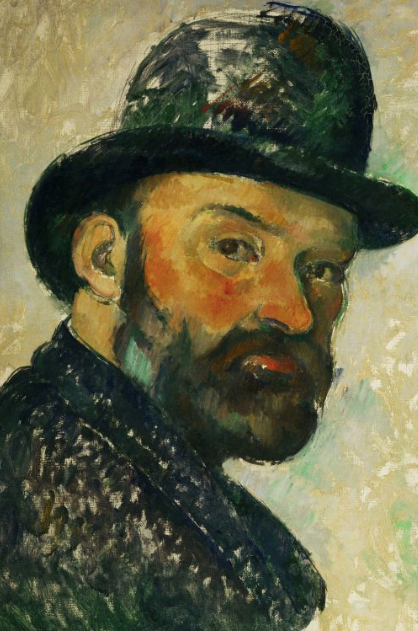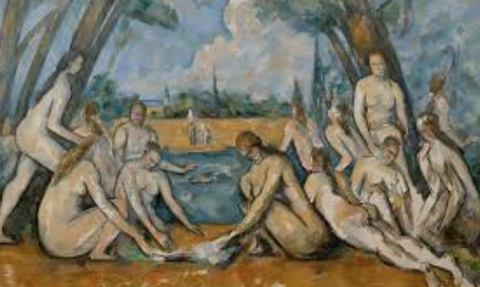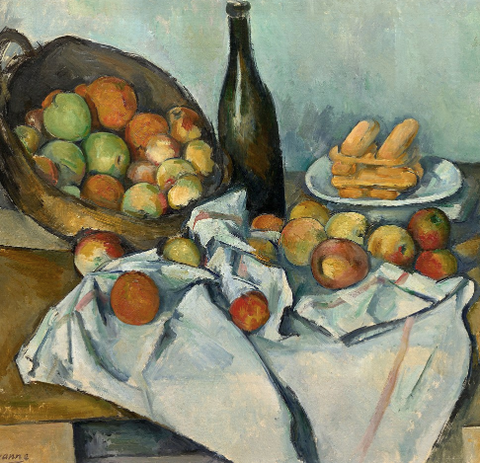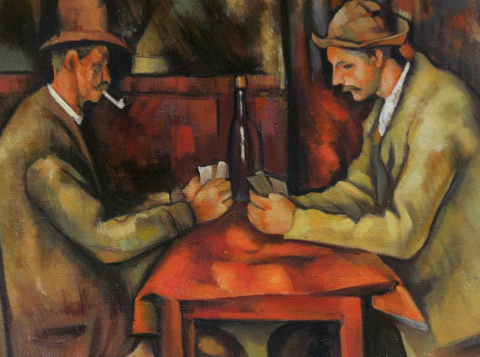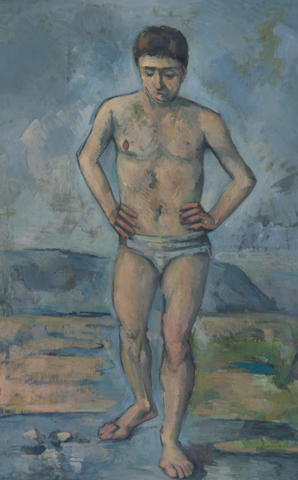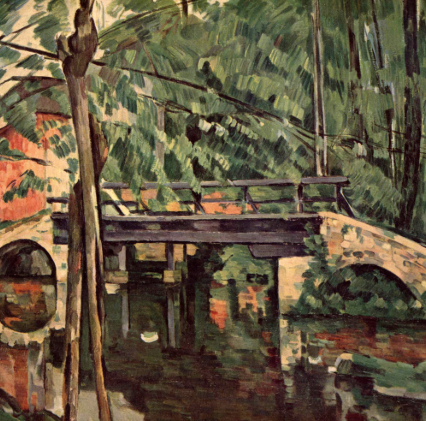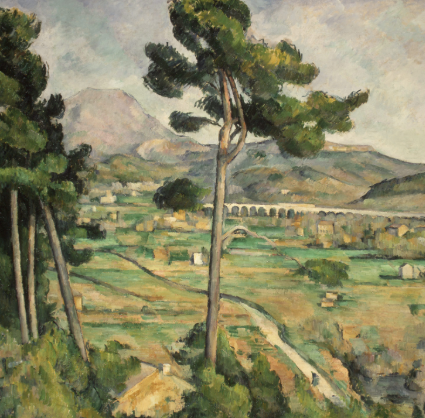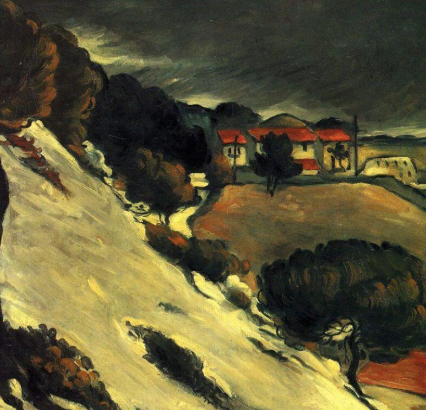Top 15 Most Famous Paintings by Paul Cézanne
Who is Paul Cezanne?
Paul Cezanne was one of the main artists of Post Impressionism. He used planes of shading and small brushstrokes into his art.
Paul Cezanne's most famous paintings:
- The Large Bathers by Paul Cézanne
- The Basket of Apples Still life by Paul Cézanne
- The Card Players by Paul Cézanne
- The boy in a Red Vest by Paul Cézanne
- The Bather by Paul Cézanne
- A Modern Olympia by Paul Cézanne
- Château Noir by Paul Cézanne
- Mont Sainte-Victoire seen from Bellevue by Paul Cézanne
- Curtain, Jug, and Fruit by Paul Cézanne
- Pyramid of Skulls by Paul Cézanne
- Maincy Bridge by Paul Cézanne
- Turning Road at Montgeroult by Paul Cézanne
- Mont Sainte-Victoire and the Viaduct of the Arc River Valley by Paul Cézanne
- Portrait of Gustave Geffroy by Paul Cézanne
- L'Estaque, Melting Snow by Paul Cézanne
Famous Artworks By Paul Cezanne
The Large Bathers by Paul Cézanne
The great bathers by Paul Cézanne
Considered by many to be the absolute masterpiece of this artist.The subject and the technique used is completely different from the standard of works that the painter has made in his artistic career.
The artist wanted to create an art that would last forever; the Cezanne bathers represents a manifesto for all those who wanted to represent a "non-commercial and counter-trend" art. The women protagonists are painted with a strong thickness and fit geometrically perfectly to the whole context; The bathers represent a tribute that Cézanne decides to pay to the great masters of the past, such as Titian and Rubens.
The strong brightness that the whole painting is due to the color that was placed several times on the canvas, which allowed Cézanne to obtain the necessary light to achieve the final effect; The strong black lines that delimit the contours of the Cezanne bathers, making them look like real statues, rather than painted. The message that Cézanne launched was immediately taken into consideration by other great names in the art world, in particular Picasso, who in the same period and also with a very similar technique gave life to his masterpiece entitled "Les Demoiselles d'Avignon".
The artistic creation was obtained in 1937 for $110,000 for the Philadelphia Museum of Art by their significant sponsor, Joseph E. Widener. Cézanne worked on this composition for a long time, and it stayed incomplete even at the hour of his passing in 1906.
Buy Claude Monet Reproduction Of Fine Art Prints On Canvas
Artist: Paul Cézanne
Year: 1898–1905
Medium: Oil-on-canvas
Dimensions: 210.5 cm × 250.8 cm (82 7⁄8 in × 98 3⁄4 in)
Location: Philadelphia Museum of Art, Philadelphia, United States
Camille Pissarro Famous Paintings | Reproduction Of Fine Arts
Paul Cezanne Paintings
The Basket of Apples Still life by Paul Cézanne
Taking a first look at The Basket of Apples, one might have a strange feeling of precarious balance; there are various parts with different balances, but when added together they conclude in a completely balanced composition.
In the central part of the painting, there is an inclined bottle and on its left there is a basket that is overturned in the opposite direction concerning the inclination of the bottle, giving a feeling of disorientation. To the right of the bottle, there is a plate with cookies, which matches the same direction as the right side of the table
The right side of the painting has nothing to do with the left one, since they're not matching each other, just as if the image were reflecting two different points of view at the same time.
All these details are not mistakes made by Cézanne, but an interesting experiment in perspective that succeeded perfectly, subsequently leading to a fundamental point in the transition from Impressionism to Cubism.
Artist: Paul Cézanne
Year: 1895
Medium: Oil on canvas
Dimensions: 65 cm × 80 cm (25.6 in × 31.5 in)
Location: Art Institute of Chicago, Chicago
20 Famous Edgar Degas Paintings [Art Masterpieces]
The Card Players by Paul Cézanne
The two players engaged in the card game are isolated from the other customers of the club. The two men are perhaps farmers and one of them was probably named Alexandre, the gardener on the estate of the artist's father in Jas de Bouffan. They are seated at a simple wooden table on which a bottle of wine closed by a cork is placed. Card Players wear simple but dignified clothing. The man on the left is wearing a jacket and a hat. While carefully evaluating his cards he smokes a pipe. The player on the right seems younger and dresses more casually. Around them, you can see the"boiserie" of the room that is the decoration of the wooden walls and the glass of a door.
The painted coffee table in a central position has the task of building the three-dimensional space through the overlapping perspective that creates the right articulation of the figures of the players interacting through the table. In constructing the space, the luminous relations of figure-ground contrast must also be taken into consideration.
Artist: Paul Cézanne
Year: 1890–1895
Medium: Oil on canvas
Dimensions: 1′ 11″ x 1′ 7″
Location: Musée d'Orsay station
Famous Paintings By Diego Rivera [Top 20 Art Masterpieces]
The boy in a Red Vest by Paul Cézanne
A boy is portrayed in the center of the painting. He is seated at a table and facing right. His torso is curved and wearily supported by his left arm. The boy's head rests on the hand that supports his cheek. He wears simple clothes and a white shirt with a red fabric waistcoat on the front and ocher color on the back. Bring a pair of blue pants. On the left, the dark interior of the room. The front wall is lighter and on it, you can see the detail of a painting.
The brush strokes are thick and irregularly arranged. In some places, you can see the intervention of spatula strokes that stretch the color with clean cuts. The boy's body seems assembled with simple and geometric shapes. Cézanne elaborated on a formal simplification to return nature to the simple forms of the cone of the cylinder and the sphere.
Artist: Paul Cézanne
Year: 1889 or 1890
Medium: Oil on canvas
Dimensions: 80 cm × 64.5 cm (31.5 in × 25.4 in)
Location: Foundation E.G. Bührle
Diego Velazquez Famous Paintings [Top 20 Fine Art Masterpieces]
The Bather by Paul Cézanne
The protagonist is a teenager, who is wearing only a small white costume, is standing in the center of the work; takes a step forward with the left foot supporting the body. The boy is of medium height and his legs with big feet. His face is bent towards the ground and his position is frontal. His hair is short and dark and creates a fringe on the forehead.
The trunk has a fine musculature while the legs are massive. Hands are resting on the hips. The left shoulder is slightly lower than the right. The land is devoid of vegetation and looks like a sandy beach. On the right, there is a puddle with little water. Finally, in the background opens a landscape devoid of details and blurred.
The sky occupies about the upper half of the canvas while the lower one is reserved for the landscape. The figure of the man joins the two horizontal halves of the painting. The figure of the teenager is summarized and the arrangement of the limbs reveals attention to geometric composition. The bent arms form two triangles thanks to the position of the hands-on-hips.
Artist: Paul Cézanne
Year: 1885
Medium: Oil on canvas
Dimensions: 4′ 2″ x 3′ 2″
Location: The Museum of Modern Art
Giorgio De Chirico Famous Artworks
A Modern Olympia by Paul Cézanne
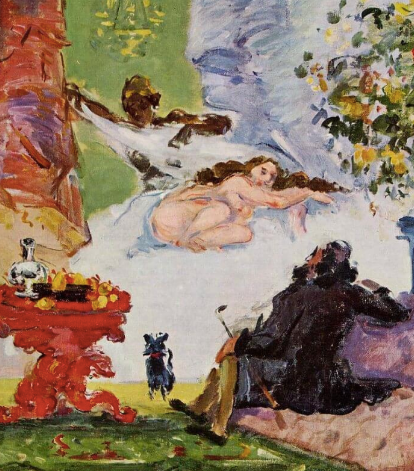
Cezanne painted two, different from each other. In 1870, he painted the first in response to a painting by Eduard Manet on the same theme and which was made in 1863, then exhibited in 1865 at the Paris Salon, where it caused a certain scandal. Later, he decided to paint another modern Olympia, using the same oil technique but developing a completely different painting.
The work "A modern Olympia" was created between 1873 and 1874; the artist, after a stay in Auvers-Sur-Oise, decided to paint a more erotic version of modern Olympia, and he used brighter colors and more dynamic design.
The movement, aroused by the black maid that undresses Olympia while a spectator observes her developing another curious movement that ends with the curtain on the left.
Artist: Paul Cézanne
Year: 1874
Medium: Oil on canvas
Dimensions: 46 x 55.5 cm
Location: Musée d'Orsay
Oskar Kokoschka Famous Paintings
Château Noir by Paul Cézanne

In Château Noir, Cézanne broke away from naturalism in a completely new way. While the Impressionists were primarily aimed at representing the world as they saw it, Cezanne didn't care.
It is impossible to determine the spatial relationship between the castle and the trees, there is a flattened effect, where these two elements appear to be directly on top of each other. The mountain is clearly in the background, but it's hard to tell how far it is. These details simply weren't important to Cézanne, who cared more about depicting deeper truths than simply reproducing what he saw in front of him.
Artist: Paul Cézanne
Year: 1903–1904
Medium: Oil on canvas
Dimensions: 2′ 5″ x 3′ 1″
Location: National Gallery of Art
Top 10 Most Famous Paintings by John William Waterhouse
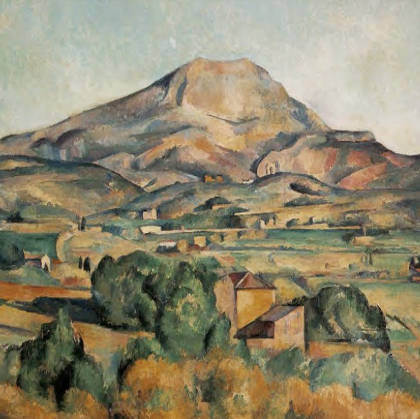
Many trees and bushes partially cover the village. Small houses with sloping roofs can be glimpsed. On the horizon rises the spur of the mountain facing right.
Paul Cézanne was not interested in impressionist atmospheres. He was a protagonist of post-impressionism. He undertook to recover the form through a search for progressive simplification of the figure. In "La Montagna Sainte-Victoire" and in the other paintings of the series, the successive simplifications are visible. In this painting, the volumes are broken down and appear as chromatic pieces that, placed alongside, build the image. As well as brushes, Cézanne also used spatulas to create sharper and more geometric backgrounds of color.
Artist: Paul Cézanne
Year: 1892–1895
Medium: Oil on canvas
Dimensions: 2′ 5″ x 3′ 0″
Location: Barnes Foundation
Paul Cézanne Mont St Victoire
Top 10 Most Famous Paintings by Georgia O'Keeffe
Curtain, Jug, and Fruit by Paul Cézanne
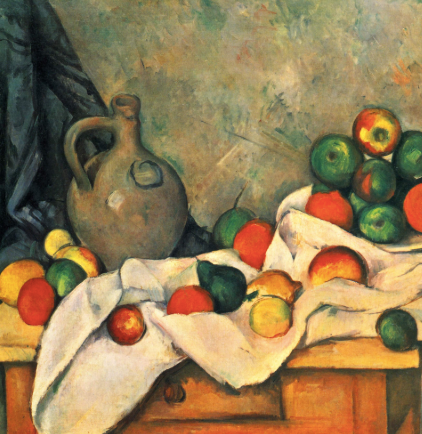
A white jug, decorated with large flowers, is placed in the center of the painting. On its sides, on the right and the left, there are two plates. The plate on the left is white with a linear decoration on the edge and there are five fruits on it. The plate on the right is smaller and contains only three apples. Other fruits are arranged behind the small plate and in front of the jug. On the support surface, some clothes hang over the edge. The cloth on the right entirely covers the corner of the table and goes down over the edge of the painting. On the left, another pale cloth is wedged under the plate and protrudes forward beyond the coffee table.
It is one of the many still lives painted by Paul Cézanne. In his still lives, as in this one of the Hermitage, the objects are always those of everyday life. The jug, the two plates, and the fruits are represented on a simple table with cloths and fabrics. In the different paintings the arrangement of the objects and the point of view change. The intimate nature of these works reveals Cézanne's introverted character.
Artist: Paul Cézanne
Year: 1893-1894
Medium: Oil on canvas
Dimensions: 60 cm × 73.0 cm (23.5 in × 28.75 in)
Location: Private collection
Top 10 Most Famous Paintings by Andy Warhol
Pyramid of Skulls by Paul Cézanne
Depict four human skulls in a pyramid configuration. Painted in a pale light against a dark background; in no other painting has Cézanne placed his objects so close to the viewer.
These skulls are piled one above the other and one behind the other, on a desk, a piece of paper taken at random under the two lower skulls, which are themselves precariously perched on the edge of the desk, facing one another. The background is mostly dark, but with hints of a richly decorated red and black carpet.
Artist: Paul Cézanne
Year: 1901
Medium: Oil on canvas
Dimensions: 14.5 in × 17.9 cm
Location: Private collection
Top 10 Most Famous Paintings by Mark Rothko
Maincy Bridge by Paul Cézanne
Masterpiece probably painted around the years when Cézanne was beginning to abandon Impressionism.
The arches of the road leading to the bridge are painted on the left and the right uphill. The light-colored stone masonry sinks into the watercourse. On the liquid surface, there are some floating plants. In the foreground, two slender trunks rise and continue beyond the upper edge of the painting. The bridge is built with simple wooden planks that finish the roadway and the protective backs. Images of the structure and vegetation are reflected in the water. Beyond the building rises a dense forest with tall, thin trunks of trees rising beyond the upper edge of the painting. On the left, you can see a building colored in ocher-orange.
Artist: Paul Cézanne
Year: 1879
Medium: Oil on canvas
Dimensions: 1′ 11″ x 2′ 4″
Location: Musée d'Orsay station
Top 10 Most Famous Paintings by Henri Matisse
Turning Road at Montgeroult by Paul Cézanne
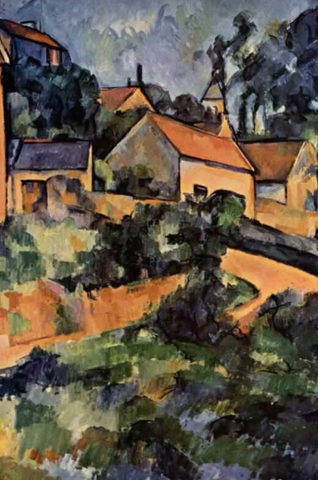
Cézanne has now abandoned Impressionism.
The lower part of the painting is occupied by a large green lawn, with the road making a bend to the right to reach the town of Montgeroult. Behind a low wall, some trees protrude. Above, you can see the small houses of the village and among them some trees. The sky takes up a small portion of the painting above and is cloudless.
The houses take on well-defined geometric shapes. The outlines of the buildings are also reinforced by heavy and rigid dark lines. The nature that surrounds the small town is made up of meadows, bushes, and crowns of trees. The brush strokes characterize the sky and the shaded facades of the houses.
Artist: Paul Cézanne
Year: 1898
Medium: Oil on canvas
Dimensions: 2′ 8″ x 2′ 2″
Location: Private collection
Top 10 Most Famous Paintings by Sandro Botticelli
Mont Sainte-Victoire and the Viaduct of the Arc River Valley by Paul Cézanne
The painting seems to be painted in a hurry, with a dense weave of vertical, furious, broken, almost feverish brushstrokes. You have the impression of looking at an out-of-focus image, a flow of color sensations, an abstract painting a vibrant forest, an undecipherable upholstery.
The vision is so concise that only by sharpening the gaze in the chromatic texture can the shapes and volumes be recognized: the ocher stain at the bottom left summarizes a house, the touches of green are the olive trees of the plain, the whites of the unpainted hemp the reflections of the light on the fields. The mountain is a blue mass that rises to two-thirds of the canvas: the line parallel to the horizon makes the extension, the green clouds of the sky reflect the trees.
Artist: Paul Cézanne
Year: 1882–1885
Medium: Oil on canvas
Dimensions: 2′ 2″ x 2′ 8″
Location: Metropolitan Museum of Art, The Metropolitan Museum of Art
Top 10 Most Famous Paintings by Thomas Sully
Portrait of Gustave Geffroy by Paul Cézanne
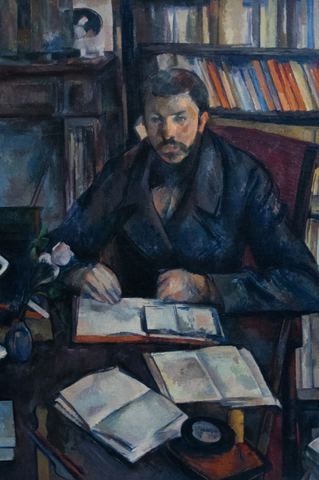
Gustave Geffroy was an art critic who had written a positive article in 1894 against Cézanne, who until then had been discriminated against and outclassed with negative comments.
The portrait of Gustave Geffroy, after Cézanne's death, was completely re-evaluated and like other works of his was considered an element of interconnection between the Impressionist and Cubist movements: in particular through in-depth studies on the composition it is possible to note that Cézanne would have before of everything painted the whole spatial area, while he would have left the face and hands of the subject in the final instance. The subject is centered and surrounded by many decorative elements, such as books, stickers, and even shelves, all placed in various ways, to give a feeling of movement within the composition.
Artist: Paul Cézanne
Year: 1895
Medium: Oil on canvas
Dimensions: 110 cm × 89 cm (43 in × 35 in)
Location: Musée d'Orsay, Paris
Top 10 Most Famous Paintings by Wassily Kandinsky
L'Estaque, Melting Snow by Paul Cézanne
Period of the war in Prussia, where Cézanne deserted: He is not ready to die for Napoleon.
The color sustains the violence of the hurricane represented in the painting. A blackish tint permeates the landscape and even snow looks like a partner of black. Painted in stark contrast, with an overwhelming, almost monotonous fury that captures the essence of a changing scene to also express a gloomy and desperate state of mind; the image has some subtle tones: the variable whites of the snow and the many grays, including the warm tones of the middle earth nestled between the red roofs. The taste for cold black, cold white, and gray seems natural to Cézanne's mood; but this taste presupposes the elegant and impassive art of Manet whose tones and immediacy of vision have been used emotionally and strangely transformed here.
Artist: Paul Cézanne
Year: 1870
Medium: Oil on canvas
Dimensions: 28.75 cm × 36.25 cm
Location: Private collection
10 Most Famous Paintings and Artworks by Raphael Urbino
Top 8 Interesting Facts About Paul Cézanne
Paul Cézanne Biography
If you like this article, please share it with others, so perhaps they can also enjoy it. Any of the artwork purchased on ATX Fine Arts accommodates me as an artist/ writer along with helping the site grow organically, thank you.

